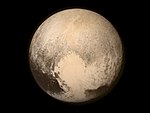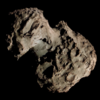 Comet Tempel 2 in 1946 from Lick Observatory | |
| Discovery | |
|---|---|
| Discovered by | Ernst Wilhelm Leberecht Tempel[1] |
| Discovery date | July 4, 1873 |
| Designations | |
| 1873 II; 1878 III; 1894 III; 1899 IV; 1904 III; 1915 I; 1920 II; 1925 IV; 1930 VII; 1946 III; 1951 VIII; 1957 II; 1962 VI; 1967 X; 1972 X; 1978 V; 1983 X; 1988 XIV; 1994 VII; | |
| Orbital characteristics | |
| Epoch | 2026-07-19 (JD 2461240.5)[2] |
| Aphelion | 4.71 AU |
| Perihelion | 1.418 AU |
| Semi-major axis | 3.065 AU |
| Eccentricity | 0.5374 |
| Orbital period | 5.37 yr |
| Inclination | 12.03° |
| 117.8° | |
| Argument of periapsis | 195.5° |
| Last perihelion | 24 March 2021[2] 14 November 2015[2][3] 4 July 2010[4][5] |
| Next perihelion | 2026-Aug-02[2][6] |
| Earth MOID | 0.41 AU (61 million km) |
| Physical characteristics | |
| Dimensions | 10.6 km[1] |
10P/Tempel, also known as Tempel 2, is a periodic Jupiter-family comet with a 5 year orbital period. It was discovered on July 4, 1873 by Wilhelm Tempel.[7] The next perihelion passage is 2 August 2026 when the comet will have a solar elongation of 164 degrees at approximately apparent magnitude 8.[4] Closest approach to Earth will be one day later on 3 August 2026 at a distance of 0.414 AU (61.9 million km).[1]
| Date & time of closest approach |
Earth distance (AU) |
Sun distance (AU) |
Velocity wrt Earth (km/s) |
Velocity wrt Sun (km/s) |
Uncertainty region (3-sigma) |
Reference |
|---|---|---|---|---|---|---|
| 2026-Aug-03 20:59 ± 1 min | 0.414 AU (61.9 million km; 38.5 million mi; 161 LD) | 1.42 AU (212 million km; 132 million mi) | 6.5 | 31.0 | ± 204 km | Horizons |
The comet nucleus is estimated to be roughly the size of Halley's Comet at 10.6 kilometers in diameter with a low albedo of 0.022.[1] The nucleus is dark because hydrocarbons on the surface have been converted to a dark, tar like substance by solar ultraviolet radiation. The nucleus is large enough that even near aphelion (furthest distance from the Sun which is near the orbit of Jupiter) the comet remains brighter than about magnitude 21.

During the 2010 apparition the comet brightened to about apparent magnitude 8.[4] The most favorable apparition of 10P/Tempel 2 was in 1925 when it came within 0.35 AU (52 million km; 33 million mi) of Earth with an apparent magnitude of 6.5.[7]




